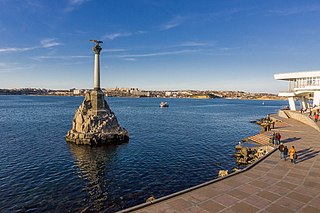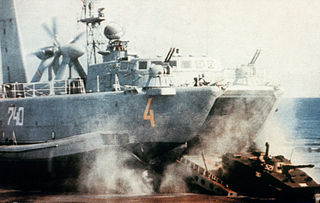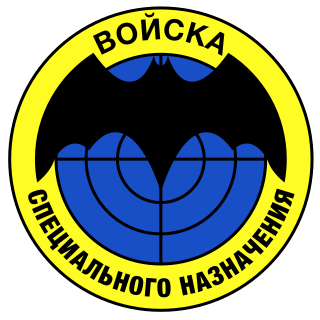Related Research Articles
Transport in Turkmenistan includes roadways, railways, airways, seaways, and waterways, as well as oil-, gas-, and water pipelines. Road-, rail-, and waterway transport fall under the jurisdiction of the Ministry of Industry and Communications.

Sevastopol, sometimes written Sebastopol, is the largest city in Crimea and a major port on the Black Sea. Due to its strategic location and the navigability of the city's harbours, Sevastopol has been an important port and naval base throughout its history. Since the city's founding in 1783 it has been a major base for Russia's Black Sea Fleet, and it was previously a closed city during the Cold War. The total administrative area is 864 square kilometres (334 sq mi) and includes a significant amount of rural land. The urban population, largely concentrated around Sevastopol Bay, is 479,394, and the total population is 547,820.

The Sea of Okhotsk is a marginal sea of the western Pacific Ocean. It is located between Russia's Kamchatka Peninsula on the east, the Kuril Islands on the southeast, Japan's island of Hokkaido on the south, the island of Sakhalin along the west, and a stretch of eastern Siberian coast along the west and north. The northeast corner is the Shelikhov Gulf. The sea is named after the Okhota river, which is in turn named after the Even word окат meaning "river".
PJSC Aeroflot – Russian Airlines, commonly known as Aeroflot, is the flag carrier and the largest airline of Russia. The airline was founded in 1923, making Aeroflot one of the oldest active airlines in the world. Aeroflot is headquartered in the Central Administrative Okrug, Moscow, with its hub being Sheremetyevo International Airport.

The Russian Navy is the naval arm of the Russian Armed Forces. It has existed in various forms since 1696; its present iteration was formed in January 1992 when it succeeded the Navy of the Commonwealth of Independent States.

The Order of the Red Banner was the first Soviet military decoration. The Order was established on 16 September 1918, during the Russian Civil War by decree of the All-Russian Central Executive Committee. It was the highest award of Soviet Russia, subsequently the Soviet Union, until the Order of Lenin was established in 1930. Recipients were recognised for extraordinary heroism, dedication, and courage demonstrated on the battlefield. The Order was awarded to individuals as well as to military units, cities, ships, political and social organizations, and state enterprises. In later years, it was also awarded on the twentieth and again on the thirtieth anniversary of military, police, or state security service without requiring participation in combat.

The Russian Naval Infantry, often referred to as Russian Marines in the West, operate as the naval infantry of the Russian Navy. Established in 1705, they are capable of conducting amphibious operations as well as operating as more traditional light infantry.

The Antonov An-124 Ruslan is a large, strategic airlift, four-engined aircraft that was designed in the 1980s by the Antonov design bureau in the Ukrainian SSR, then part of the Soviet Union (USSR). The An-124 is the world's second heaviest gross weight production cargo airplane and heaviest operating cargo aircraft, behind the destroyed one-off Antonov An-225 Mriya and the Boeing 747-8. The An-124 remains the largest military transport aircraft in service.

The Soviet Navy was the naval warfare uniform service branch of the Soviet Armed Forces. Often referred to as the Red Fleet, the Soviet Navy made up a large part of the Soviet Union's strategic planning in the event of a conflict with the opposing superpower, the United States, during the Cold War (1945–1991). The Soviet Navy played a large role during the Cold War, either confronting the North Atlantic Treaty Organization in western Europe or power projection to maintain its sphere of influence in eastern Europe.

The Baltic Fleet is the fleet of the Russian Navy in the Baltic Sea.
Atran, LLC is a cargo airline based in Moscow, Russia. It operates cargo charters in Europe, Russia and the CIS. Its main base is Domodedovo International Airport, Moscow.

The Russian commando frogmen, informally called "commando frogmen" in civilian media, are a Russian Naval Spetsnaz unit under operational subordination to the Main Intelligence Directorate (GRU). It is the special forces unit of the Russian Naval Infantry and is composed of highly trained and elite marines within the Naval Infantry. By virtue of belonging to the Russian Naval Infantry, frogmen fall under the Coastal Troops of the Russian Navy service arm. The Russian Navy proper does not field any special forces or special operations units. Russian FSB special forces Alpha Group and Vympel also have frogman units in their respective naval components.

Sadko was a Soviet icebreaker known for its role in scientific expeditions in the Arctic. Built as SS Lintrose in 1913 for ferry service in Newfoundland, she was sold to the government of the Russian Empire in 1915 and renamed Sadko. In Russia, she was used as a freighter in the Arctic before sinking in 1916.

The military ranks of the Soviet Union were those introduced after the October Revolution of 1917. At that time the Imperial Russian Table of Ranks was abolished, as were the privileges of the pre-Soviet Russian nobility.

The Black Sea Shipyard is a shipbuilding facility in Mykolaiv, Ukraine, on the southern tip of the of Mykolaiv peninsula. It was founded in 1895 by Belgian interests and began building warships in 1901. At the beginning of World War I in 1914, it was one of the largest industrial facilities in the Russian Empire. The shipyard was moribund in the first decades of the Soviet Union until the Soviets began building up their fleet in the 1930s and it began building surface warships as well as submarines. The yard was badly damaged during World War II and took several years to be rebuilt. Surface warship construction temporarily ended in the mid-1950s before being revived in the mid-1960s and submarines were last built in the yard in late 1950s. The Black Sea Shipyard built all of the aircraft carrying ships of the USSR and Russia and continued before the 2022 Russian invasion of Ukraine to build large commercial ships.

The Aist class was the first large assault hovercraft operated by the Soviet Navy. It was designed by the Almaz design bureau wing of the Almaz Shipbuilding Company in 1964–1965. Production of the craft lasted from 1970 until 1985 at Almaz's plant in Leningrad.

Spetsnaz GRU or Spetsnaz G.U. (formally known as Special Forces of the Main Directorate of the General Staff of the Russian Armed Forces is the special forces of the GRU, the foreign military-intelligence agency of the Armed Forces of the Russian Federation.

Sevastopol Marine Trade Port (SMTP) is a port in Sevastopol. It is located mainly at the Bay of Sevastopol, and at smaller bays around the Heracles peninsula. The port infrastructure is fully integrated with the city of Sevastopol and naval bases of the Russian Navy and the Black Sea Fleet.
The Aeroflot passenger fleet consists of narrow-body and wide-body aircraft from six aircraft families: the Airbus A320, the Airbus A330, the Airbus A350, the Boeing 737, the Boeing 777, and the Sukhoi Superjet 100. As of July 2022, there are 181 passenger aircraft registered in the Aeroflot fleet.

Russian whaling has been conducted by native peoples in the Chukotka region of Russia since at least 4,000 years ago by native Yupik and Chukchi people, but commercial whaling did not begin until the mid-19th century, when companies based in Finland sent out vessels to the Pacific. It was not until 1932 that modern pelagic whaling began to take off with the purchase of an American cargo ship which was renamed the Aleut, which was the only Soviet factory ship until World War II. After the war, with the need for a stronger Soviet economy and rapid industrialization of the country during the 1940s and 1950s, Soviet whaling took off and became a truly global industry. The first Soviet whalers reached the Antarctic during the 1946–47 season with the factory ship Slava and then underwent a rapid expansion during the late 1950s in which 5 new fleets were added within a 4-year span: Sovetskaya Ukraina in 1959, Yuriy Dolgorukiy in 1960, and Sovetskaya Rossiya in 1961 for the Antarctic, and finally two large fleets in 1963 for the North Pacific. Thus, by the early 1960s Soviet whaling had truly become a global industry, operating in every ocean except the North Atlantic and undertaking voyages that could last as long as seven months each. From 1964 to 1973, the Soviet Union was considered by some the biggest whaling nation in the world.
References
- 1 2 "Commercial Fleet in the History of Russia" (in Russian)